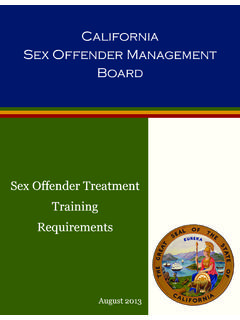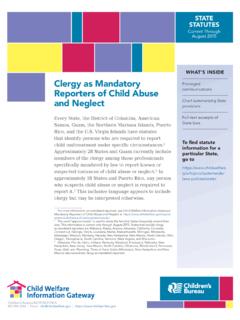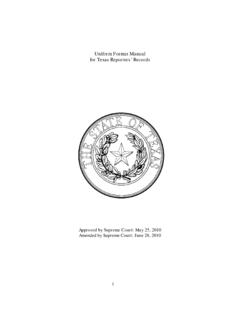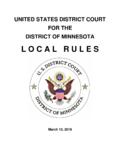Transcription of Post Conviction Sex Offender Polygraph Standards …
1 post - Conviction Sex Offender Polygraph Standards January 2017. California Sex Offender Management Board Phone: | Email: post - Conviction SEX Offender Polygraph CERTIFICATION. Standards . Introduction .. 1. 1. Model Policy 2. Compliance and local authority .. 2. Periodic review and 2. 2. Evidence-based approach 2. Face-valid principles .. 2. Evolving evidence .. 3. 3. PCSOT program goals 3. Containment approach .. 3. Operational objectives .. 3. 4. Decision-support 3. Professional judgment .. 4. Successive hurdles approach .. 4. Confidentiality .. 5. 5. General principles 5. Rights and dignity of all persons.
2 5. Polygraph examiner as part of the supervision and treatment team .. 5. Non-interference with ongoing investigations .. 5. Known and unknown 5. Confirmatory testing .. 5. Ethical and professional roles .. 6. Number and length of examinations .. 6. Examination techniques .. 6. 6. Operational definitions 6. CASOMB post - Conviction Sex Offender Polygraph Certification Standards Table of Contents i 7. Examination questions 8. Relevant questions .. 8. Comparison questions .. 9. 8. Types of PCSOT examinations 9. Instant offense exams .. 10. Instant offense exam .. 10. Instant offense investigative exam.
3 10. Prior allegation exam ..11. Sexual history exams I and II .. 12. Sex history form .. 12. Sexual history exam I .. 13. General sex history history exam 14. Maintenance 18. Sex offense monitoring exam .. 21. 9. Suitability for testing 22. Medications .. 23. Unsuitable examinees .. 23. Team approach .. 23. Incremental validity .. 24. 10. Testing procedures 24. Case background information .. 24. Audio-visual or audio recording .. 24. Pre-test 24. In-test operations .. 26. Test data 27. Posttest 28. 11. Examination report 28. Dissemination of test results and information .. 29. CASOMB post - Conviction Sex Offender Polygraph Certification Standards Table of Contents ii Scope of expertise.
4 29. 12. Records retention 29. 13. Quality assurance 29. 14. Examiner qualifications 29. Specialized training .. 29. Continuing education .. 29. Professional experience .. 30. CASOMB post - Conviction Sex Offender Polygraph Certification Standards Table of Contents iii STATE OF CALIFORNIA. post - Conviction Sex Offender Polygraph Certification Standards By the California Sex Offender Management Board (CASOMB). Introduction: California Penal Code Section 9003 (3) (c) requires the California Sex Offender Management Board (CASOMB) to develop and update Standards for certification of Polygraph examiners conducting post - Conviction Polygraph examinations of sex offenders.
5 However, CASOMB is not legislatively mandated to certify Polygraph examiners and therefore does not do so. All polygraphers working with certified sex Offender management programs must meet the certification Standards adopted by the CASOMB. These Standards were published on the Board's internet website on July 1, 2011. CASOMB adopted the Model Policy for post - Conviction Sex Offender Testing published by the American Polygraph Association (APA) in May of 2009. After reviewing the 2016. APA Model Policy and consulting with several expert California Polygraph examiners, it was determined to continue to use the 2009 edition.
6 CASOMB believes that continuing its use of the 2009 APA Model Policy as the Standards to be followed in California will serve the needs of the state quite well. Additionally, CASOMB strongly recommends that Polygraph examiners be involved members of the APA and the California Association of Polygraph Examiners. CASOMB reserves the right to revise these Standards and requirements at any time. These criteria are for those mental health practitioners who provide treatment and evaluation of all sex offenders pursuant to Penal Code section CASOMB post - Conviction Sex Offender Polygraph Certification Standards (1/2017) 1.
7 1. Model Policy. This Model Policy should be considered a description of recommended best-practices for Polygraph professionals who engage in post - Conviction sex Offender testing (PCSOT) activities. This Model Policy is intended to provide a basis for local programs developing or updating their PCSOT. regulations, and does not attempt to address all aspects of PCSOT programming or policy implementation at the local level. Compliance and local authority. Examiners should be responsible for knowing and adhering to all legal and regulatory requirements of their local jurisdictions. In case of any conflict between the Model Policy and any local practice requirements, the local regulations should prevail.
8 Examiners who work in jurisdictions and programs without local regulations should refer to this Model Policy as a guide. Compliance with this Model Policy. Although this Model Policy should be considered non-binding and not enforceable by the APA or any local jurisdiction, examiners whose work varies from the recommendations of this Model Policy should be prepared to provide justification for doing so. Compliance with professional Standards . Unless prohibited by law, regulation or agency policy, all members of the American Polygraph Association (APA) shall comply with the APA Standards of Practice.
9 Additionally, all examiners should be responsible for knowing and adhering to Standards of ASTM International. Periodic review and modification. This Model Policy should be reviewed and amended periodically in order to remain consistent with emerging information from new empirical studies. 2. Evidence-based approach. To the extent possible, this Model Policy relies on knowledge and principles derived from existing research pertaining to Polygraph testing, risk assessment, risk management, and sex Offender treatment. Examiners should be cautious of field practices based solely on a system of values or beliefs.
10 Some elements of this Model Policy are intended to increase professionalism and reliability among field examiners through the implementation of standardized field practice recommendations in the absence of data from empirical studies. Face-valid principles. When an evidence-based approach is not possible, the Model Policy emphasizes face-valid principles pertaining to Polygraph testing, field investigation principles and related fields of science. These include psychology, physiology, mental health treatment, forensic threat assessment, signal detection, decision theory, and inferential statistics.













